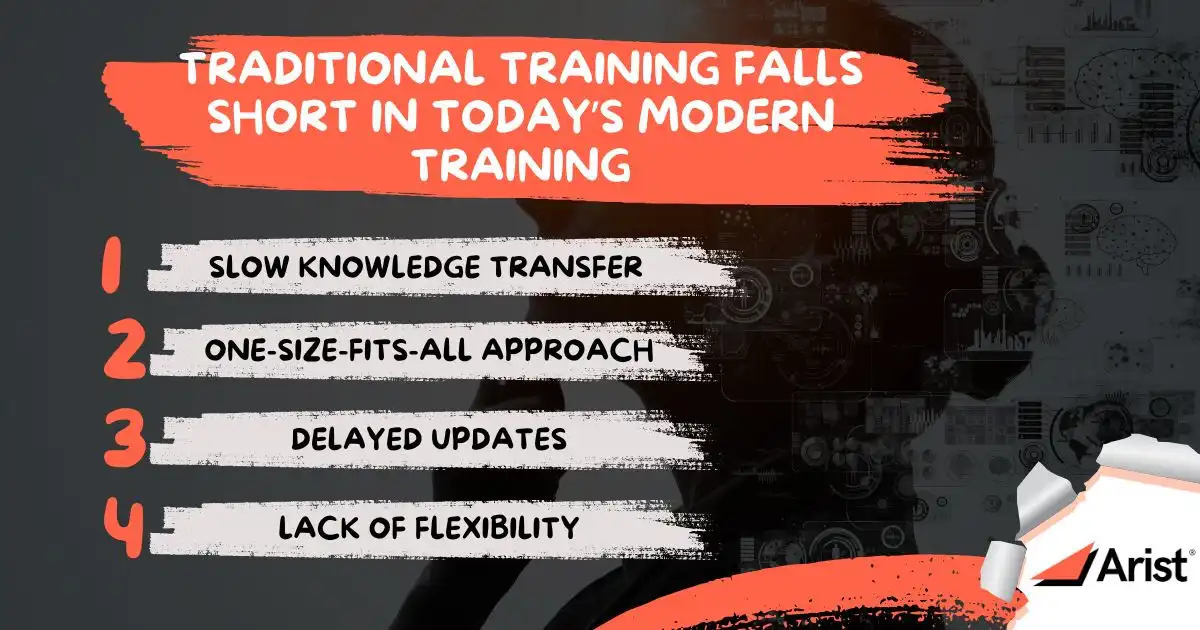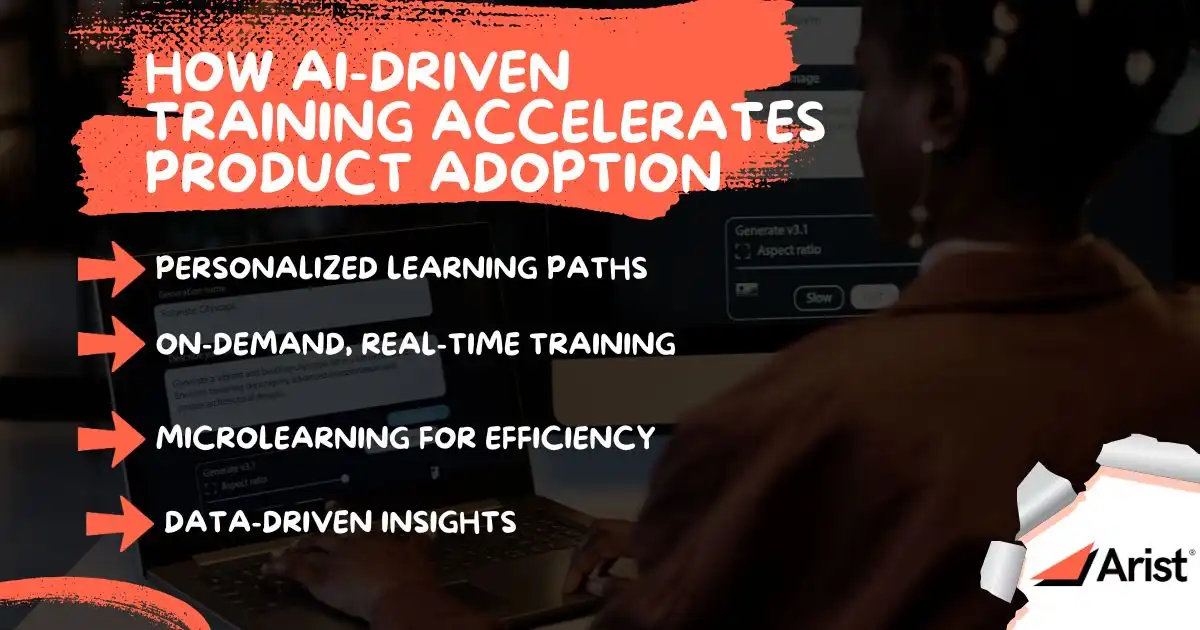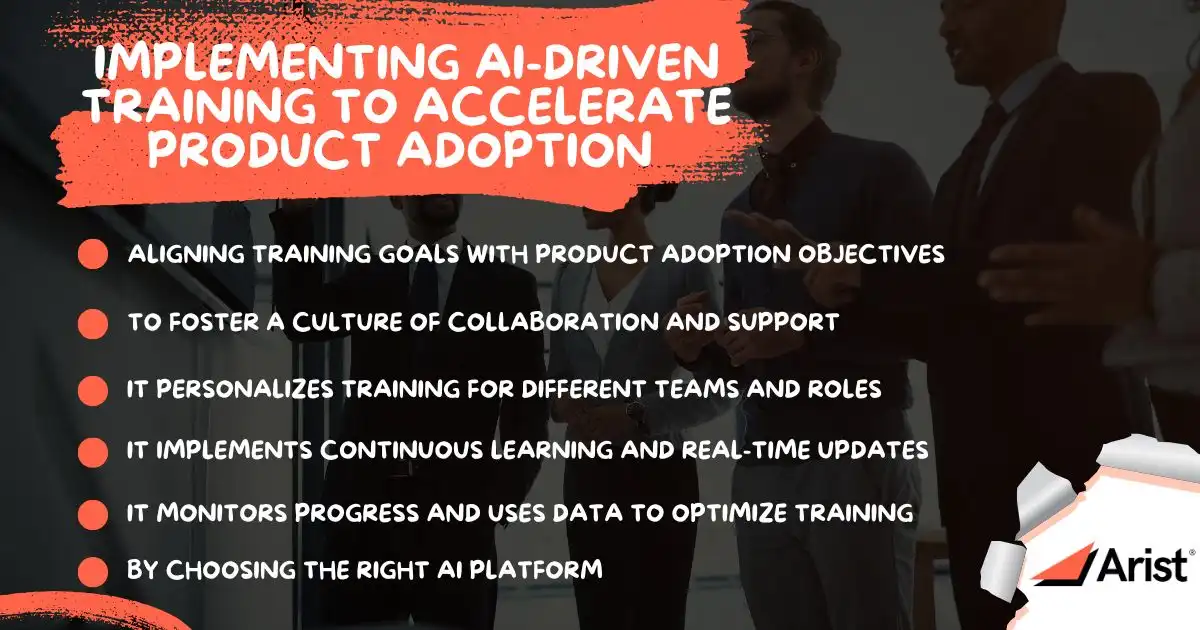AI-Driven Training: The Secret to Faster Product Adoption
Launching a product and watching it gain traction effortlessly is a rewarding experience; teams are aligned, customers are engaged, and results are delivered without delays. With the advent of technology, traditional training often falls short of keeping up with innovation, for example, delayed integration of new technology, lack of real-time updates, and inability to adapt to rapidly evolving skills.
AI-driven training changes the game, transforming how knowledge is shared and adopted. This training approach can accelerate your product adoption strategy — an essential employee training strategy that every business or organization with a sales team should prioritize.
Why Traditional Training Falls Short In Today’s Modern Training?

1. Slow Knowledge Transfer
Traditional training often relies on lengthy sessions, manuals, or workshops requiring significant time and effort. The knowledge transfer process can feel outdated or incomplete when training is completed. Employees may struggle to retain and apply what they’ve learned, delaying their ability to work effectively with new products.
This slow pace is particularly problematic in industries where speed is critical. In competitive markets, waiting weeks or months for teams to grasp new product details fully can result in missed opportunities, lost revenue, and diminished employee and customer confidence.
2. One-Size-Fits-All Approach
Offering the same material to all employees regardless of their roles, experience, or learning preferences typically takes a generalized approach, which traditional training methods provide. While this might save time in preparation, it often leads to disengagement and inefficiency.
For example, a sales team needs to focus on features that appeal to customers, while a technical team may require in-depth functionality knowledge. Providing the same training to both groups means neither receives the tailored content they need to excel in their roles—this lack of personalization results in uneven understanding, knowledge gaps, and slower team adoption.
3. Delayed Updates
One of the biggest challenges with traditional training is its inability to adapt quickly to changes. Products evolve rapidly, frequently introducing new features, updates, and enhancements. Conventional training materials, such as printed manuals or static presentations, are often outdated before they reach employees.
As a result, teams are left with incomplete or inaccurate information, which can lead to confusion, miscommunication, and reduced confidence when interacting with customers. Without real-time updates, organizations risk falling behind in staying competitive.
4. Lack of Flexibility
Traditional training typically requires employees to leave their regular tasks to participate in lengthy workshops or sessions. For busy teams, this can disrupt workflows and decrease productivity. Moreover, rigid schedules often fail to accommodate individual learning speeds, leaving some employees struggling to keep up while others feel their time is being wasted.
Flexibility is key in today’s workplace. Employees need training that fits into their schedules, not vice versa. Unfortunately, traditional methods rarely provide this level of adaptability, making them less effective in fast-paced environments.
How AI-Driven Training Accelerates Product Adoption

Adopting new products successfully requires speed, precision, and adaptability, which traditional training methods often lack. AI-driven training offers a smarter, more dynamic solution, addressing key challenges and paving the way for faster product adoption. Here’s how AI takes training to the next level:
Personalized Learning Paths
One of the most significant advantages of AI-driven training is its ability to adapt to the unique needs of each individual. Employees differ in their roles, expertise, and learning styles, which traditional methods rarely account for. It bridges this gap by creating personalized learning paths tailored to:
Role-specific needs: A sales rep might receive modules focusing on customer pain points and product benefits, while a technical team member might dive into system functionality.
Learning speeds: Fast learners can progress quickly, while others receive additional support without feeling rushed.
By focusing on what each team member needs to know, AI eliminates irrelevant information and ensures everyone gets up to speed faster and more effectively.
On-Demand, Real-Time Training
AI empowers organizations to deliver training exactly when it’s needed. As products evolve and updates are rolled out, employees can access the most current information in real time. Unlike traditional training, which may require scheduling sessions or distributing updated materials, AI-driven platforms instantly disseminate product updates, features, and relevant content at the right time. This ensures that teams remain aligned with the product’s evolution, accelerating their ability to adopt and implement changes.
Microlearning for Efficiency
Long, drawn-out training sessions can overwhelm employees and hinder retention. AI-driven training addresses this with microlearning, which consists of short, focused modules designed for quick consumption and better retention. The benefits of microlearning include bite-sized knowledge and flexibility for busy schedules. This approach speeds up the training process and improves long-term knowledge retention, making it easier for teams to apply what they’ve learned.
Data-Driven Insights
AI doesn’t just deliver training, but it also measures its effectiveness. Analyzing performance metrics and learning patterns provides actionable insights that help organizations optimize their training strategies. This can also benefit the company by identifying knowledge gaps, tracking progress, and continuous improvement. This ensures no employee is left behind, creating a well-prepared and confident workforce.
Implementing AI-driven Training To Accelerate Product Adoption

1. By Aligning Training Goals with Product Adoption Objectives
Before diving into AI-driven training, defining clear, measurable goals that align with your product adoption strategy is crucial. Start by identifying the key product knowledge and skills that need to be developed for different teams to succeed. Consider the following:
Key product features: What specific product features must be understood by each team (e.g., customer-facing vs. technical teams)?
Performance milestones: How will you measure success in the adoption process (e.g., faster customer onboarding, improved sales performance, reduced support queries)?
By aligning training objectives with product adoption goals, you ensure that AI-driven training focuses on the areas that matter most, driving the outcomes you need.
2. To Foster a Culture of Collaboration and Support
While AI can streamline and enhance product adoption, it’s important to complement it with human support. Foster a culture of collaboration by integrating AI-driven training with:
Peer Learning: Encourage team members to share insights and tips about the product, creating a collaborative learning environment.
Mentorship and coaching: Pair newer employees with experienced mentors who can provide guidance and answer questions in real time, blending AI-driven learning with human interaction.
Customer support: Ensure your customer support team is well-trained in using AI tools to assist customers during their adoption journey confidently.
A strong support system combining AI-driven training with human collaboration reinforces the learning process and accelerates product adoption for employees and customers.
3. It Personalizes Training for Different Teams and Roles
AI excels in delivering personalized, role-specific training that speaks to the needs of each team member. Once you’ve chosen the right platform, configure it to provide targeted content based on employees' roles, experience levels, and learning preferences. Here’s how:
Tailored content: For sales teams, focus on product benefits, use cases, and customer objections. For technical teams, focus on product architecture, troubleshooting, and advanced features.
Adaptive learning paths: AI can adapt to individual learning speeds, so a more experienced employee may skip basic modules, while newer employees can receive foundational knowledge to build their understanding.
Real-Time feedback: AI can track progress and provide real-time feedback to users, helping them improve continuously without waiting for formal assessments.
By personalizing training, AI ensures that employees learn what they need to know efficiently, accelerating product adoption across diverse teams.
4. It Implements Continuous Learning and Real-Time Updates
Product adoption doesn’t happen overnight. To ensure employees stay aligned with evolving products, creating an environment of continuous learning is essential. AI facilitates this by offering:
On-demand learning: Employees can access training anytime, ensuring they can refresh their knowledge or learn about new product updates.
Real-time product updates: AI platforms automatically integrate new content into training modules as product features evolve. This ensures that your team is constantly updated with the latest product details.
Microlearning modules: AI can break down training into small, digestible chunks that employees can efficiently complete during breaks or between tasks. This reduces the time commitment for employees while still delivering impactful learning.
Continuous learning with real-time updates ensures that product knowledge is always fresh, empowering your team to adopt new products quickly and confidently.
5. It Monitors Progress and Uses Data to Optimize Training
One of the most significant advantages of AI-driven training is its ability to collect and analyze data. To maximize the effectiveness of your AI training program:
Track Performance Metrics: Monitor how well employees absorb product knowledge through metrics such as completion rates, quiz scores, and learning speed.
Identify Knowledge Gaps: Use AI’s data analysis tools to pinpoint areas where employees struggle. Provide additional resources or training to ensure no one is left behind.
Refine Content: Regularly review the training content based on learner feedback and performance data. Use AI insights to tweak and improve the modules, ensuring they remain relevant and practical.
By continuously monitoring progress and leveraging AI's data insights, you can optimize the training experience and accelerate product adoption.
6. By Choosing the Right AI Platform
Selecting the right AI platform is critical to ensure seamless implementation. The platform you choose should offer the following:
Scalability: As your team grows or your product evolves, the AI platform should be able to handle more users and continuously update its content without disruptions.
User-friendly Interface: The platform should be intuitive for learners and administrators, making it easy for teams to access training and for managers to track progress.
Integration with Existing Systems: Ensure that the AI platform integrates with your existing tools and systems, such as learning management systems (LMS), CRM software, or communication tools. This integration will streamline the learning experience and facilitate adoption.
Evaluate different platforms to find the one that best suits your company’s size, structure, and training needs. The right platform will be a foundation for effective AI-driven product adoption.
Boost Product Adoption With Smarter, AI-Powered Training Solutions
Traditional training methods often fall short, leaving teams unprepared and delaying product adoption. Slow knowledge transfer, generic content, and outdated materials create roadblocks that hinder growth. But there’s a smarter way forward.
At Arist, we specialize in AI-driven training solutions to transform how your teams learn and adopt new products.
Arist offers innovative AI-driven training solutions designed to accelerate product adoption effectively. Here’s how their services contribute to streamlined and successful product adoption:
Microlearning Delivery: Deliver concise, engaging, and actionable lessons in short, digestible formats.
Personalized Learning Paths: AI adapts content to individual learning needs, ensuring role-specific and skill-relevant training.
Real-Time Insights: Arist enables instant updates to training materials, ensuring teams stay up-to-date.
Data-Driven Insights: AI-powered analytics track real-time progress, engagement, and knowledge gaps.
With personalized learning paths, empower your workforce to master product knowledge faster and more effectively. Let Arist show you how. Book a demo today and see the difference smarter training can make in your team.
Arist Team
Bring
real impact
to your people
We care about solving meaningful problems and being thought partners first and foremost. Arist is used and loved by the Fortune 500 — and we'd love to support your goals.
Curious to get a demo or free trial? We'd love to chat:


